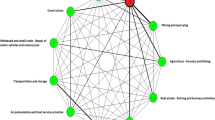Abstract
We perform Monte Carlo simulations to study the effect of increasing the frequency of observations and data span on the Johansen (J Econ Dyn Control 12(2–3):231–254, 1988; Likelihood-based inference in cointegrated vector autoregressive models, Oxford University Press, Oxford, 1995) maximum likelihood cointegration testing approach, as well as on the bootstrap and wild bootstrap implementations of the method developed by Cavaliere et al. (Econometrica 80(4):1721–1740, 2012; Econ Rev 33(5–6):606– 650, 2014). Considering systems with three and four variables, we find that when both the data span and the frequency vary, the power of the tests depend more on the sample length. We illustrate our findings by investigating th existence of long-run equilibrium relationships among four indicators prices of coffee.
Similar content being viewed by others
Notes
It is likely that changes over time in the structure and regulation of the coffee market may have caused structural breaks. The effect of temporal aggregation on such breaks is left as a topic for further research though.
References
Brewer, K. (1973). Some consequences of temporal aggregation and systematic sampling for ARMA and ARMAX models. Journal of Econometrics, 1(2), 133–154.
Cavaliere, G., Rahbek, A., & Taylor, R. (2012). Bootstrap determination of the co-integration rank in vector autoregressive models. Econometrica, 80(4), 1721–1740.
Cavaliere, G., Rahbek, A., & Taylor, R. (2014). Bootstrap determination of the co-integration rank in heteroskedastic VAR models. Econometric Reviews, 33(5–6), 606–650.
Dickey, D., & Fuller, W. (1979). Distribution of the estimators for autoregressive time series with a unit root. Journal of the American Statistical Association, 74(366), 427–431.
Engle, R., & Granger, C. (1987). Co-integration and error correction: Representation, estimation, and testing. Econometrica, 55(2), 251–76.
Haug, A. A. (2002). Temporal aggregation and the power of cointegration tests: A Monte Carlo study. Oxford Bulletin of Economics and Statistics, 64(4), 399–412.
Hooker, M. (1993). Testing for cointegration: Power versus frequency of observation. Economics Letters, 41(4), 359–362.
Johansen, S. (1988). Statistical analysis of cointegration vectors. Journal of Economic Dynamics and Control, 12(2–3), 231–254.
Johansen, S. (1995). Likelihood-based inference in cointegrated vector autoregressive models. Oxford: Oxford University Press.
Johansen, S. (2002). A small sample correction for the test of cointegrating rank in the vector autoregressive model. Econometrica, 70(5), 1929–1961.
Lahiri, K., & Mamingi, N. (1995). Testing for cointegration: Power versus frequency of observation—Another view. Economics Letters, 49(2), 121–124.
MacKinnon, J., Haug, A., & Michelis, L. (1999). Numerical distribution functions of likelihood ratio tests for cointegration. Journal of Applied Econometrics, 14(5), 563–77.
Marcellino, M. (1999). Some consequences of temporal aggregation in empirical analysis. Journal of Business and Economic Statistics, 17(1), 129–136.
Otero, J., & Smith, J. (2000). Testing for cointegration: Power versus frequency of observation—Further monte carlo results. Economics Letters, 67(1), 5–9.
Rossana, R., & Seater, J. (1995). Temporal aggregation and economic time series. Journal of Business and Economic Statistics, 13(4), 441–451.
Said, S. E., & Dickey, D. A. (1984). Testing for unit roots in autoregressive-moving average models of unknown order. Biometrika, 71(3), 599–607.
Schwarz, G. (1978). Estimating the dimension of a model. Annals of Statistics, 6(2), 461–464.
Shiller, R., & Perron, P. (1985). Testing the random walk hypothesis: Power versus frequency of observation. Economics Letters, 18(4), 381–386.
Swensen, A. (2006). Bootstrap algorithms for testing and determining the cointegration rank in VAR models. Econometrica, 74(6), 1699–1714.
Tiao, G. (1972). Asymptotic behaviour of temporal aggregates of time series. Biometrika, 59(3), 525–531.
Vogelvang, E. (1992). Hypotheses testing concerning relationship between spot prices of various types of coffee. Journal of Applied Econometrics, 7(2), 191–201.
Acknowledgements
We are grateful to two anonymous referees for their detailed comments and suggestions. The usual disclaimer applies.
Author information
Authors and Affiliations
Corresponding author
Additional information
Publisher's Note
Springer Nature remains neutral with regard to jurisdictional claims in published maps and institutional affiliations.
Rights and permissions
About this article
Cite this article
Otero, J., Panagiotidis, T. & Papapanagiotou, G. Multivariate Cointegration and Temporal Aggregation: Some Further Simulation Results. Comput Econ 59, 59–70 (2022). https://doi.org/10.1007/s10614-020-10062-w
Accepted:
Published:
Issue Date:
DOI: https://doi.org/10.1007/s10614-020-10062-w




